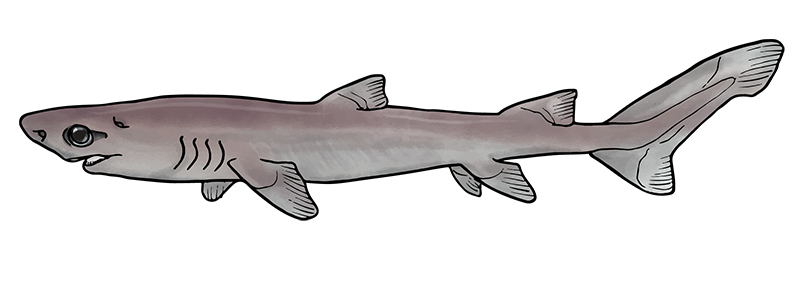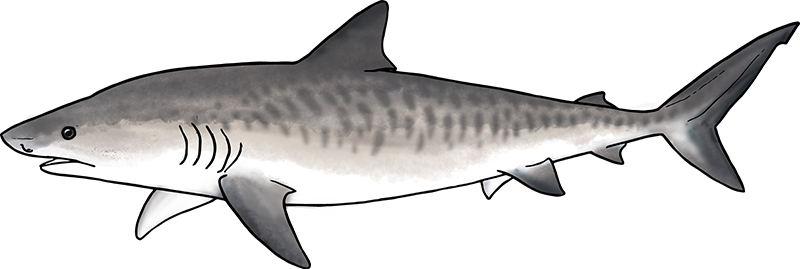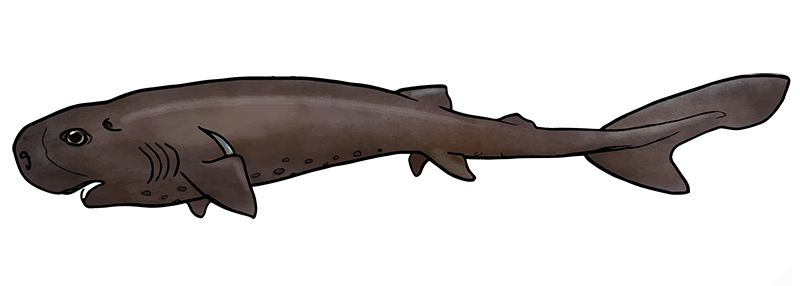
Visualizaing Shark Numbers

Sharks have inhabited the earth for more than 400 million years, having outlived the dinosaurs and many other creatures currently alive [1]Source: WWF .
But sharks are now in deep trouble. Every year, roughly 100 million sharks are caught and killed by humans [2] Marine Policy (2013) Global catches, exploitation rates, and rebuilding options for sharks, mostly as a result of bycatch and shark finning.
Industrial fishing fleets throughout the world supply countries in Asia to help satisfy local demand in shark fin, while the shark meat market continues to expand globally, thanks to a growing appetite in Latin America — such as in Brazil and Uruguay [3]Source: FAO.
Most pelagic sharks are caught on the high seas in tuna and swordfish fisheries, resulting in dramatic declines for some populations — by as much as 98% over the past 15 years [4]Source: WildAid. According to the International Union for Conservation of Nature (IUCN), nearly one third of pelagic shark species are now considered threatened [5]Source: IUCN.
In staggering contrast to the hundreds of millions of sharks who have fallen victim each year to human predation, about ten human beings die by shark attack.
The media's tendency to portray sharks as vicious monsters, then, seems not only dishonest and misleading, but cruel in comparison.
Moreover, it is not true that all shark species are predators. Some, in fact, are ordinary filter feeders. In this visualization you will learn about various shark species, their plight, and about how we can fight to ensure their survival.
Visualizaing Shark Numbers

Sharks have inhabited the earth for more than 400 million years, having outlived the dinosaurs and many other creatures currently alive [1]Source: WWF .
But sharks are now in deep trouble. Every year, roughly 100 million sharks are caught and killed by humans [2] Marine Policy (2013) Global catches, exploitation rates, and rebuilding options for sharks, mostly as a result of bycatch and shark finning.
Industrial fishing fleets throughout the world supply countries in Asia to help satisfy local demand in shark fin, while the shark meat market continues to expand globally, thanks to a growing appetite in Latin America — such as in Brazil and Uruguay [3]Source: FAO.
Most pelagic sharks are caught on the high seas in tuna and swordfish fisheries, resulting in dramatic declines for some populations — by as much as 98% over the past 15 years [4]Source: WildAid. According to the International Union for Conservation of Nature (IUCN), nearly one third of pelagic shark species are now considered threatened [5]Source: IUCN.
In staggering contrast to the hundreds of millions of sharks who have fallen victim each year to human predation, about ten human beings die by shark attack.
The media's tendency to portray sharks as vicious monsters, then, seems not only dishonest and misleading, but cruel in comparison.
Moreover, it is not true that all shark species are predators. Some, in fact, are ordinary filter feeders. In this visualization you will learn about various shark species, their plight, and about how we can fight to ensure their survival.
What can you do to help save sharks?
1. Reduce seafood consumption and only consume sustainable seafood. In particular, avoid species such as tuna and swordfish (these fisheries lead to a lot of shark bycatch) unless you know they are sustainably caught. Avoid seafood overall if you don't know the source and when they are likely fished commercially.
2. Don't consume shark fin soup. In particular, if you are based in East Asia, when planning wedding banquets pay attention to the default menus as they often include shark fin soup. Raising awareness about the cruelty of shark finning is important, since many people may not be aware.
3. Avoid consuming other shark products, such as shark meat. Moreover, shark cartilage and oils can be found in many products such as cosmetics.
4. Reduce / avoid consuming single-use plastic and reduce waste.
5. Educate and raise awareness about sharks as much as you can!

Thank you for reading!
Due to space limitations, the approximate maximum depth recorded for each species is shown.
To see the exact depth hover over each species.
Shark numbers
How many sharks species do you know? Great white shark? Whale shark?
You can see the approximately 510 species here, with each circle representing a species and the size of the circle is proportional to the maximum size of that species. Hover over the circles to see details.
The approximately 510 species of sharks are found in 34 different families. Some families have over 100 species while others only have one, such as the whale shark.
Sharks can be found from the surface to down to around 4000 meters deep, as far as current records show.
Shark extremes
SILKY SHARK
As seen in the chart before, Silky sharks have been recorded as far down as 4000 meters!
They are named after the silky look of their skin, which is a result of densely packed scales [6]Source: Florida Museum species profiles Carcharhinus falciformis.
They are often taken in the directed pelagic shark fishery but also in the swordfish and tuna fishery as bycatch in different regions of the world.
GREENLAND SHARK
The Greenland Shark is the longest-lived of all sharks, the oldest one recorded was 512 years old [7]Science (2016) Eye lens radiocarbon reveals centuries of longevity in the Greenland shark! They only reach sexual maturity at around 150 years old.
Iceland is the only country in the world where its meat is consumed. Hákarl [8] Source: Wikipedia is a national dish of Iceland that consists of a Greenland shark or other sleeper sharks that has been cured with a fermentation process and hung to dry for months.
POCKET SHARK
There are two species of Pocket Sharks, and at first glance they look more like whales than sharks with their bulbous heads!
Up until recently there was only one species of Pocket Shark (Mollisquama parini) known from one specimen collected back in 1979, it was 40 cm in length.
The American Pocket Shark (Mollisquama mississippiensis) was recently described, increasing the total number of pocket shark specimens collected to two and the number of pocket shark species described also to two. It is also one of the smallest shark species as the specimen collected was only 14 cm in length [9] Source: Wikipedia ! Moreover, the new species potentially glows in the dark!
[10] Zootaxa (2019) A new Western North Atlantic Ocean kitefin shark (Squaliformes: Dalatiidae) from the Gulf of Mexico. .
It is distinguished from other sharks by two pockets next to its front fins. The pockets are largr and can reach around 4% of the shark's body length.
THRESHER SHARKS
Thresher sharks are characterized by long, scythe-like tails that can be as long as their bodies and are used to stun prey.
All three species of thresher sharks are listed as vulnerable on the IUCN Redlist, as their low fecundity and late sexual maturity cannot sustain high levels of exploitation.
Many countries fish thresher sharks commercially often through offshore longline and pelagic gillnet fisheries. They are often also caught as bycatch [11] Source: Marine Conservation Society .
The shark fin trade is also a serious threat to thresher sharks as their large fins are highly valued.
WHALE SHARKS
Whale sharks are the largest known fish species alive! They only reach sexual maturity at around 30 years and can live for 70 to potentially 130 years [12]
Marine & Freshwater Research (2018) Comparing length-measurement methods and estimating growth parameters of free-swimming whale sharks (Rhincodon typus) near the South Ari Atoll, Maldives !
They are ovoviviparous, which means that they give birth to live young, and they can have up to 300 pups at once (see the small circles to the left)!
Though whale sharks can reach up to 12 meters, their favorite food is plankton. They are filter feeders and they feed by passively filtering everything in their paths with their mouths open.
SHORT-FIN MAKO SHARKS
The shortfin mako is the fastest-swimming shark, reaching up to 68 km / h [13] J.ofExp.Bio (1990) Aspects of shark swimming performance determined using a large water tunnel , with bursts up to 90 km / h.
Of all studied sharks, the shortfin mako has one of the largest brain to body ratios. They are apparently very fast-learning sharks.
They have been listed as endangered by IUCN in a recent assessment. They are caught globally as target and bycatch in pelagic commercial and small-scale longline, purse seine, and gillnet fisheries [14] Source: IUCN , often being targeted for their fins and their meat.
Bycatch in tuna and billfish fisheries as well as sport fishing are major threats that are driving population decline [15] Source: Nakawe Project .
Shark Strangeness
SAWSHARKS
Sawsharks have long snouts with sharp teeth protruding from either side, which is used for slashing their prey. They also have long barbels towards the middle of their snout, which they use along with electro-receptors (ampullae of Lorenzini) on the underside of the saw are to sense prey buried in the sand [16] Source: WildAid .
Sawsharks can sometimes be confused with sawfish, a type of ray that superficially look like sawsharks, but the two groups have evolved the saw-like snouts independently. Sawfish lack barbels and can be up to 4.5 times larger than sawsharks [17] Source: Mongabay .
BASKING SHARKS
Basking sharks are the second largest shark species, reaching up to 8 meters, only topped by the whale shark. Similar to whale sharks, they go near the surface of the water to filter feed on plankton.
Basking sharks used to thrive in groups of hundreds to thousands off the coast of California over 100 years ago, but by the 1960s they were rarely spotted. The great news is that recently they have been sighted more frequently in the same region! [18] Source: The Guardian Otherwise, they are frequently sighted in the waters of Scotland during the summer months.
Sharks in trouble
Sharks, as well as their close relatives the rays and chimaeras, are particularly vulnerable to overfishing and bycatch because they mature late and produce few young
With the current unprecedented scale of commercial fishing, many species are continuing to decline and more are becoming endangered.
How many species are threatened?
Approximately 15-16% of shark species are threatened with extinction (CR: 10, EN: 21, VU: 48) under the Red List criteria of IUCN. Comparatively, about 13-14% of birds and 25% of mammals are threatened [19] Source: IUCN .
However, about 45% of shark species are listed as data deficient or not evaluated , and many of them could likely be under threat, given their similar life history and morphology to the listed species.
How threatened is each family?
Which species are protected by CITES?
CITES is a treaty that regulates the trade of different species.
Only 22 species of sharks are protected under CITES, and except for the sawsharks that are listed under Appendix I, the rest are all under Appendix II!
Over 1400 species of birds and nearly 900 species of mammals are protected under CITES compared to the 20 shark species [20] Source: CITES , even though over 130 shark species are listed as threatened or near threatened by IUCN.
Bycatch
Bycatch is one of the main drivers of shark population declines. An estimated 50 million sharks are caught as bycatch in commercial fisheries each year.
A study [21] Science (2003) Collapse and Conservation of Shark Populations in the Northwest Atlantic investigated the decline of coastal and pelagic species in the Atlantic over 8-15 years.
The results are staggering. Many shark populations have declined between 60 and 90%.
BLUE SHARKS
Blue sharks are highly migratory species, they cross oceans basins in order to go to areas with high density food sources as well as to mate. They use their large pectoral fins to ride long currents to conserve energy [22] Source: Oceana.
They are the most fished shark of all shark species, commonly as bycatch in longline and driftnet fisheries but sometimes also targeted for their fins and meat. Their large fins make them very valuable for the fin trade.
They were historically one of the most common pelagic sharks in the world, but now approximately 20 million of these sharks are killed every year by humans [23]Source: Florida Museum species profiles Prionace glauca, and some populations have decreased by 80%.
Shark fin trade
Approximately 70 million sharks are killed each year for their fins, and some shark populations have declined over 90% in the past decades.
All 14 shark species most prevalent in the shark fin trade (displayed on the left) are all threatened or near threatened with extinction [24]Source: Shark Savers!
Hammerheads, oceanic whitetips and blue sharks are the preferred species for shark fin soup while dogfish, mako sharks and tope sharks are often caught for their meat.
What can you do to help save sharks?
1. Reduce seafood consumption and only consume sustainable seafood. In particular, avoid species such as tuna and swordfish (these fisheries lead to a lot of shark bycatch) unless you know they are sustainably caught. Avoid seafood overall if you don't know the source and when they are likely fished commercially.
2. Don't consume shark fin soup. In particular, if you are based in East Asia, when planning wedding banquets pay attention to the default menus as they often include shark fin soup. Raising awareness about the cruelty of shark finning is important, since many people may not be aware.
3. Avoid consuming other shark products, such as shark meat. Moreover, shark cartilage and oils can be found in many products such as cosmetics.
4. Reduce / avoid consuming single-use plastic and reduce waste.
5. Educate and raise awareness about sharks as much as you can!

Thank you for reading!



